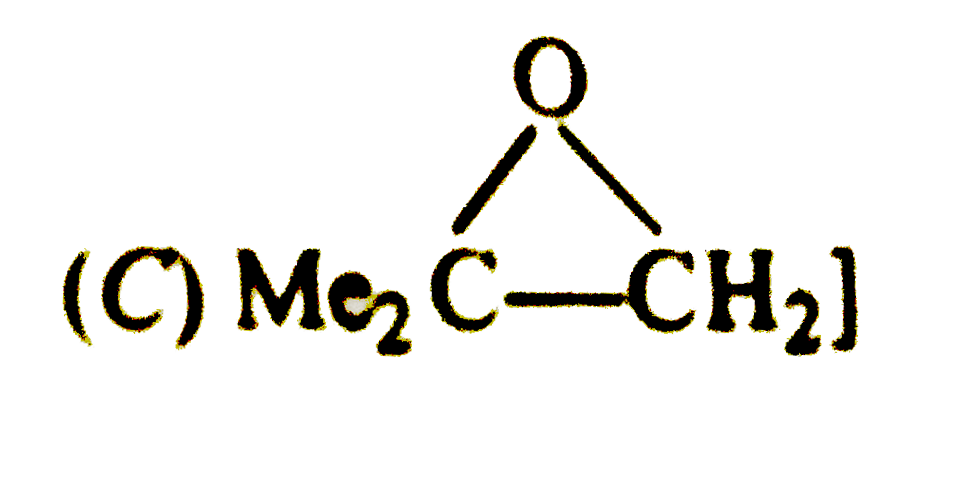In the following reaction C is, CH3−CH=CH2+ HCl
Organic−−−−−−→PeroxideAAg2O−−−−−→MoistBEt MgBr−−−−→C
n –propanol
Isopropanol
Propane
Ethane
The correct Answer is:D
To solve the given reaction step by step, we will analyze each part of the reaction and identify the products formed at each stage.
Step 1: Identify the starting material and the reaction conditions.
- The starting material is CH₃-CH=CH₂ (propene).
- The reaction is with HCl in the presence of an organic peroxide.
Step 2: Apply the Anti-Markovnikov rule.
- When HCl reacts with an alkene in the presence of peroxides, the reaction follows the Anti-Markovnikov rule. This means that the hydrogen atom from HCl will add to the carbon with more hydrogen atoms (the terminal carbon), and the chloride will add to the carbon with fewer hydrogen atoms (the middle carbon).
- Therefore, the product A formed will be CH₃-CHCl-CH₃ (2-chloropropane).
Step 3: Reaction with moist Ag₂O.
- The product A (2-chloropropane) is then treated with moist Ag₂O. In this reaction, the chloride ion (Cl⁻) will be replaced by a hydroxyl group (OH⁻) from the moisture present.
- The product B formed will be CH₃-CH(OH)-CH₃ (2-propanol).
Step 4: Reaction with Grignard reagent (EtMgBr).
- The product B (2-propanol) then reacts with the Grignard reagent (EtMgBr). In this reaction, the Grignard reagent will react with the hydroxyl group, leading to the formation of a new carbon-carbon bond.
- The hydrogen from the hydroxyl group will bond with the ethyl group from the Grignard reagent, resulting in the formation of ethane (C₂H₆) and a magnesium alkoxide (C₂H₅MgBr).
Final Product:
- The final product C is C₂H₆ (ethane).
Summary of the Steps:
1. Start with CH₃-CH=CH₂ and react with HCl (peroxide) → A: CH₃-CHCl-CH₃.
2. React A with moist Ag₂O → B: CH₃-CH(OH)-CH₃.
3. React B with EtMgBr → C: C₂H₆ (ethane).
- The starting material is CH₃-CH=CH₂ (propene).
- The reaction is with HCl in the presence of an organic peroxide.
- When HCl reacts with an alkene in the presence of peroxides, the reaction follows the Anti-Markovnikov rule. This means that the hydrogen atom from HCl will add to the carbon with more hydrogen atoms (the terminal carbon), and the chloride will add to the carbon with fewer hydrogen atoms (the middle carbon).
- Therefore, the product A formed will be CH₃-CHCl-CH₃ (2-chloropropane).
- The product A (2-chloropropane) is then treated with moist Ag₂O. In this reaction, the chloride ion (Cl⁻) will be replaced by a hydroxyl group (OH⁻) from the moisture present.
- The product B formed will be CH₃-CH(OH)-CH₃ (2-propanol).
- The product B (2-propanol) then reacts with the Grignard reagent (EtMgBr). In this reaction, the Grignard reagent will react with the hydroxyl group, leading to the formation of a new carbon-carbon bond.
- The hydrogen from the hydroxyl group will bond with the ethyl group from the Grignard reagent, resulting in the formation of ethane (C₂H₆) and a magnesium alkoxide (C₂H₅MgBr).
- The final product C is C₂H₆ (ethane).
1. Start with CH₃-CH=CH₂ and react with HCl (peroxide) → A: CH₃-CHCl-CH₃.
2. React A with moist Ag₂O → B: CH₃-CH(OH)-CH₃.
3. React B with EtMgBr → C: C₂H₆ (ethane).
Topper's Solved these Questions
- HALOALKANES & HALOARENES BOOK - VMC MODULES ENGLISHCHAPTER - HALOALKANES & HALOARENES EXERCISE - EFFICIENT
100 Videos
- HALOALKANES & HALOARENES BOOK - VMC MODULES ENGLISHCHAPTER - HALOALKANES & HALOARENES EXERCISE - IMPECCABLE
100 Videos
- HALOALKANES & HALOARENES BOOK - VMC MODULES ENGLISHCHAPTER - HALOALKANES & HALOARENES EXERCISE - IMPECCABLE
100 Videos
- ENVIRONMENTAL CHEMISTRYBOOK - VMC MODULES ENGLISHCHAPTER - ENVIRONMENTAL CHEMISTRYEXERCISE - JEE Main (Archive)
39 Videos
- HALOALKANES AND HALOARENESBOOK - VMC MODULES ENGLISHCHAPTER - HALOALKANES AND HALOARENESEXERCISE - IN-CHAPTER EXERCISE - F
6 Videos
Similar Questions
Knowledge Check
Supply structural formulae for missing compounds.
(i) H2C=CH2+(A)→ClCH2−CH2OHH2SO4−−−−−−→413K(B)alc. KOH−−−−−−−→Δ(C)
(ii) CH3CHBrCH3alc. KOH−−−−→(A)HBr−−−−−→Peroxide(B)CH3ONa−−−−−→(C)
(iii) Me3CBralc. KOH−−−−→(A)HOCl−−−→(B)NaOH−−−→(C)
 AABCCH3CH=CH2CH3CH(Br)CH2BrCH3CH(OH)CH3BABCCH3CH=CH2CH3CH2CH2BrCH3CH2OCH2CH2CABCCH2CH=CH3CH3CH(Br)CH3CH3CH2OCH2CH2DABCCH2CH=CH3CH3CH2CH2BrCH2CH2CH2OCH3
AABCCH3CH=CH2CH3CH(Br)CH2BrCH3CH(OH)CH3BABCCH3CH=CH2CH3CH2CH2BrCH3CH2OCH2CH2CABCCH2CH=CH3CH3CH(Br)CH3CH3CH2OCH2CH2DABCCH2CH=CH3CH3CH2CH2BrCH2CH2CH2OCH3
What is the major product alkene formed in the following elimination?
CH3CH2CH2CH3∣N+∣CH3−CH3∣C∣CH3−CH3Δ−−→
View SolutionIn the given reaction sequences the final product 'C' is
CH3−CH2−OH(i)KMnO4/−OH/Δ−−−−−−−−−−−−−−−→(ii)H2O+(A)(i)SOCl2−−−−−−−−→(ii)NH3(B)Br2/KOH−−−−−−→(C)
View SolutionWrite structures of compounds A,B and C in each of the following reactions:
(i) C6H5BrMg/dry ether−−−−−−−→A(a)CO2(g)−−−−−−−→(b)H3O+BPCl5−−→C
(ii) CH3CN(a)SnCl2/HCl−−−−−−−−−→(b)H3O+Adil.NaOH−−−−−→BΔ−−→C
View SolutionComplete the following reaction CH3−C∣CH3=CH−CH3H2,Ni−−−→?
View Solution(A)Alc.KOH−−−−−→CH3−CH=CH2HBr−−−−−−→(Peroxide)(B) Find the product (A) and (B) in the given reaction
View SolutionConsider the following sequence of reactions
C2H5C≡CHCH3MgBr−−−−−→A(1)HCHO−−−−−−→(2)H2O+B
The product (B) is
View SolutionWhat is the product of the following reaction : CH3−C∣CH3=CH2HBr−−−−→Peroxide
View Solution